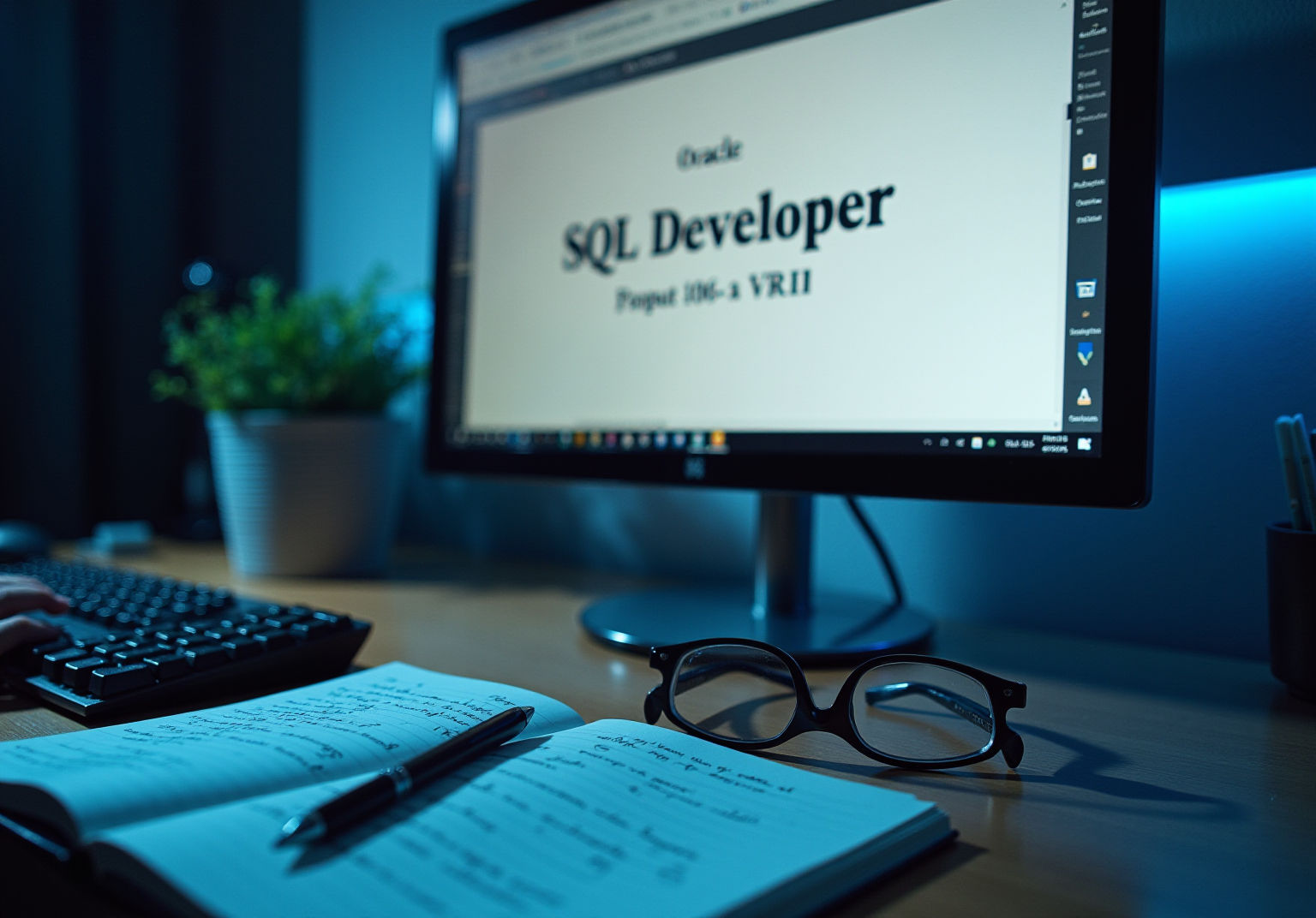
Overview
You might be wondering how to check the Oracle Database version, right? Well, this article lays out four effective methods that are super important for making sure everything runs smoothly—think compatibility, troubleshooting, and keeping your database secure and performing at its best. It dives into:
- SQL commands
- Handy GUI tools like Oracle SQL Developer
- Database management tools
- Log files
Each method is tailored to different user preferences, making your database management journey a whole lot easier!
Key Highlights:
- Knowing your Oracle Database version is crucial for compatibility with applications and avoiding service disruptions.
- Database version awareness aids in troubleshooting by allowing access to relevant documentation and targeted solutions.
- Staying updated with the latest database version enhances performance, security, and feature availability.
- Compliance with industry regulations often requires specific data storage formats, making version knowledge essential.
- SQL commands like 'SELECT * FROM v$version;' provide direct access to database version details.
- Graphical User Interface (GUI) tools like Oracle SQL Developer simplify the process of checking the database version.
- Database management tools display release information prominently, streamlining update checks.
- Log files can also reveal release details, although they are less common for this purpose.
- Regularly checking database statistics is crucial for maintaining optimal performance.
Introduction
You might be wondering why understanding the version of an Oracle Database matters. Well, it’s more than just a technical detail; it’s a critical factor that influences compatibility, troubleshooting, and security. As organizations increasingly rely on robust data systems, knowing how to check the database version can save you from costly disruptions and help ensure you’re compliant with industry regulations. But with so many methods available—from SQL commands to graphical interfaces—you might ask yourself, how can you determine the best approach to efficiently check your Oracle Database version? Let’s dive into that!
Understand the Importance of Knowing Your Oracle Database Version
Understanding your Oracle Database version is super important for a few key reasons, and you might be wondering why it matters.
First off, let’s talk about compatibility. Different applications and tools often rely on to work their best. For instance, many organizations are still running on older systems like 10g and 9i, which can lead to compatibility headaches with newer applications. Knowing how to helps you keep everything in sync across your software ecosystem, preventing any .
Now, what about troubleshooting? If issues pop up, knowing the exact version of your database can really help in figuring out what’s gone wrong. It allows you to find targeted solutions and access the right documentation, speeding up the whole resolution process. Diana Robete puts it perfectly— is key for .
And let’s not forget about upgrades! If you’re planning to upgrade, it is essential to know how to check database version in Oracle. Newer releases usually come with , and crucial that can protect your organization from vulnerabilities. With Oracle processing a whopping 33 billion transactions daily, staying updated is vital for handling that kind of volume efficiently.
Lastly, adherence is something you can't overlook. Many industries have strict regulations that require specific data storage formats. Knowing your version helps ensure you’re compliant, avoiding any potential legal and financial headaches. Non-compliance can lead to hefty penalties, so it’s crucial to stay informed about your database release.
By grasping the importance of knowing your 's version, you set yourself up to manage it more effectively. This means making informed decisions about maintenance and updates, leading to improved and fewer risks in database management. So, let’s keep that dialogue going—how are you handling your database updates?
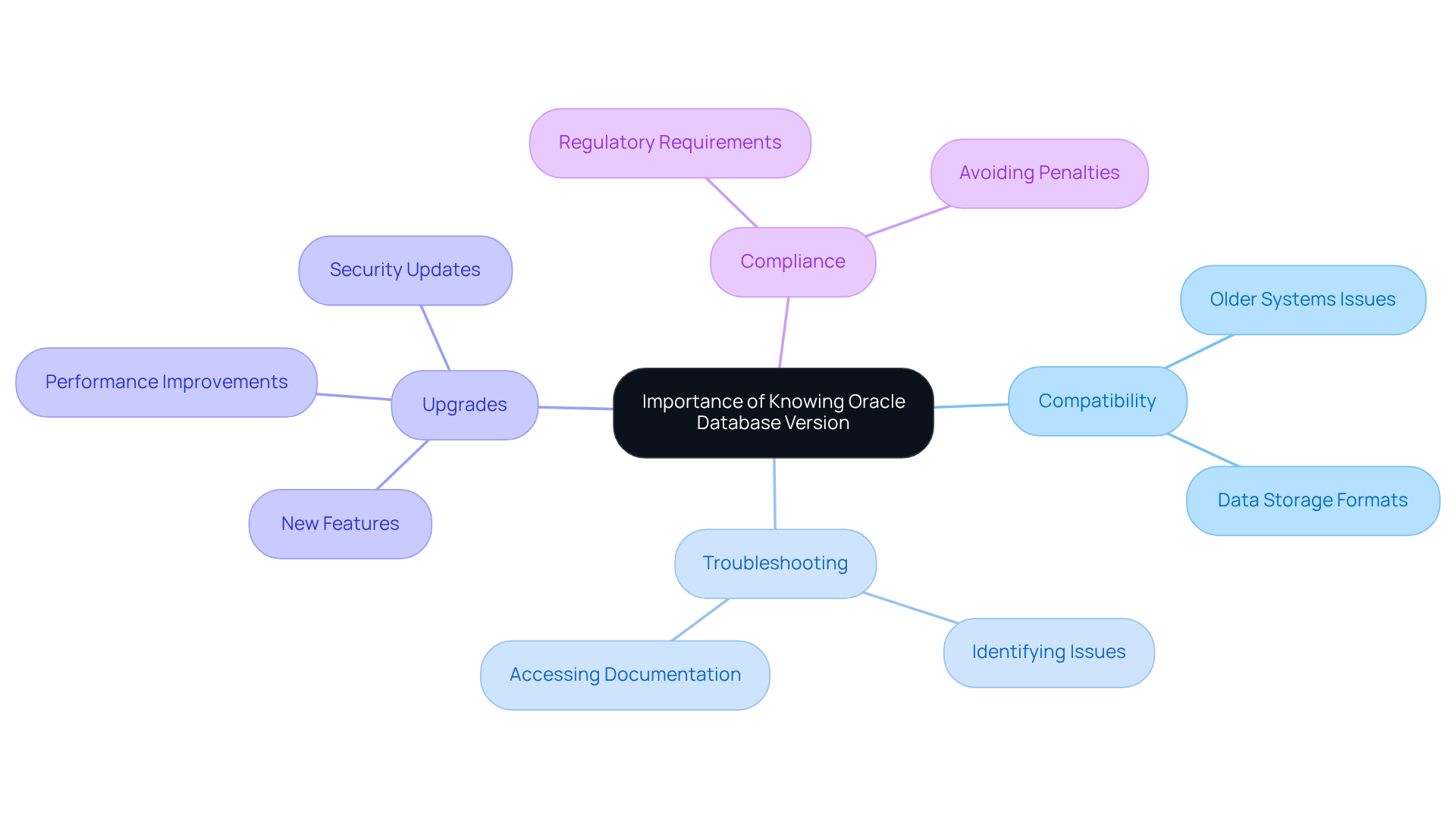
Explore Different Methods to Check Oracle Database Version
You might be wondering . Well, there are several effective methods out there, each catering to different user preferences. Let’s dive into them!
First up, we have . If you’re comfortable with command-line interfaces, this method is perfect for you. Just run a simple SQL query like SELECT * FROM v$version;, and voilà! You get direct access to all the juicy release details. As Kiran Kumar points out, "The Oracle optimizer utilizes statistics to ascertain the most effective method to execute a query." This really highlights how important those precise commands are in managing your data.
Now, if you prefer a more visual approach, are the way to go. These tools make it super easy to view release information without needing to type out any commands. They simplify the process, making it accessible even for those who aren’t as familiar with SQL.
Then we have . Many of these come packed with features that prominently display release information, making it easy to access. Using these tools can really streamline the process of checking for updates, ensuring you’re always in the loop with the latest information.
Lastly, there are . While this method isn’t as common, it can still be useful for uncovering release details. You might have to sift through various logs, but it can be a handy option, especially when troubleshooting.
Each of these methods has its own perks, so you can choose the one that best demonstrates how to check database version in Oracle according to your style and resources. And remember, consistently checking your system’s version is crucial for keeping everything running smoothly. As Kiran Kumar emphasizes, " is essential for sustaining optimal query efficiency." If you want to boost your efficiency even further, incorporating the DBMS_STATS package can help ensure you have the most accurate and up-to-date information at your fingertips.
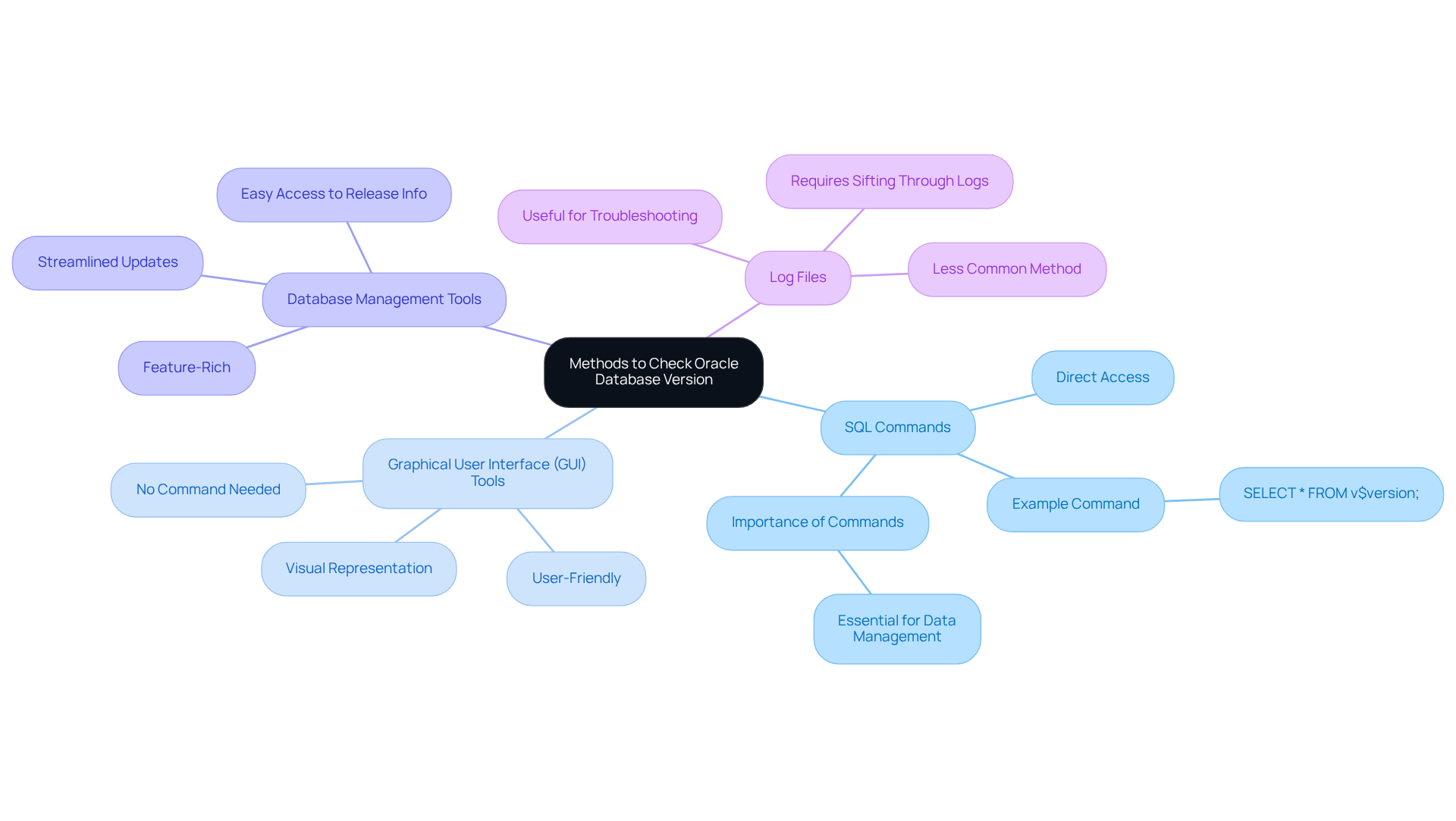
Use SQL Commands to Retrieve Oracle Database Version
You might be wondering using . It’s pretty straightforward! Just follow these steps:
First, open SQL*Plus or SQL Developer—whichever SQL interface you prefer. Next, connect to the system by entering your username and password. Now, let’s dive into executing the command. You can run one of these SQL commands:
SELECT * FROM v$version;SELECT version FROM PRODUCT_COMPONENT_VERSION;SELECT version FROM PRODUCT_COMPONENT_VERSION WHERE product LIKE 'Oracle%';SELECT * FROM v$instance;
Once you’ve executed the command, take a moment to review the output. It will show you the along with some extra details about the , formatted as major release.minor release.patch level.
These commands are super handy for . Interestingly, face check errors about 30% of the time! It is crucial to understand [how to check database version in Oracle](https://process.st/how-to/check-your-oracle-version) for . It helps administrators evaluate compatibility with applications, plan necessary upgrades, and . Plus, insights from perspectives like DBA_REGISTRY_HISTORY and DBA_HIGH_WATER_MARK_STATISTICS can provide valuable historical records. So, remember to consistently verify your system's release for optimal performance of your data management system!
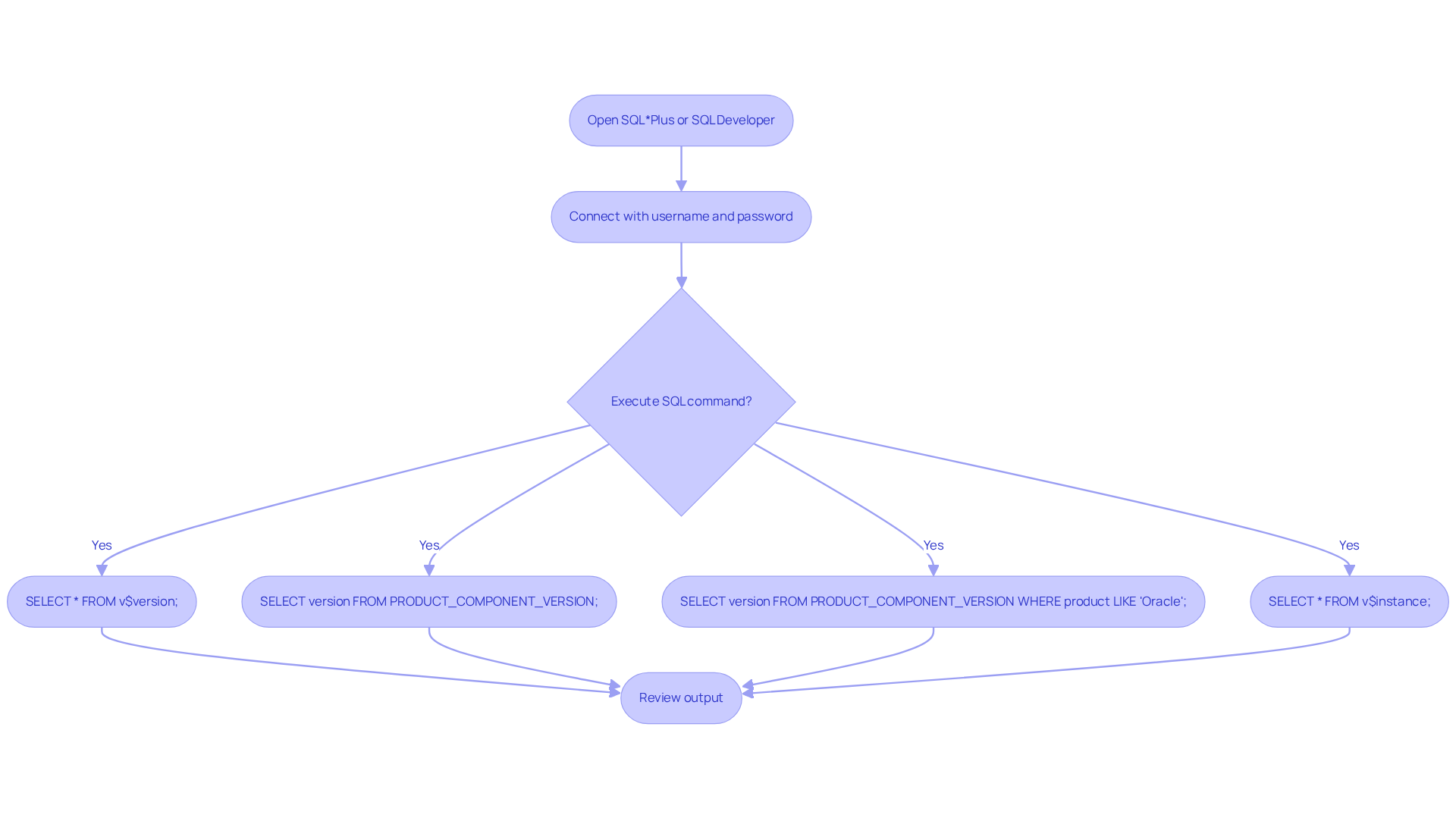
Utilize GUI Tools for Checking Oracle Database Version
If you’re someone who enjoys graphical interfaces, checking your database version can be a breeze! Let’s walk through it step-by-step:
- Open : Go ahead and launch the application, then connect to your data repository. This tool is super popular for its and powerful features—no wonder it’s a favorite among !
- Navigate to the Connection: Pick your data connection from the list. This little step lets you dive into the specific details about your database instance.
- View Database Information: Keep an eye out for the release information in the connection details or under the 'About' section. You’ll usually spot the release number right there, making it easy to grab that essential info.
- Use : If you’ve got access, log in to Oracle Enterprise Manager. Head over to the data repository, where you can find the release noted under the configuration settings. This tool really digs deep, offering extensive insights into data performance and configuration, which can boost user satisfaction.
Using GUI tools like SQL Developer and Enterprise Manager simplifies how to in Oracle and . It’s all about of data environments! According to , Oracle SQL Developer has received glowing reviews for its ease of use, with many organizations reporting a boost in efficiency for management tasks. Plus, experts suggest that regularly checking is key to keeping things running smoothly—after all, informed decision-making is crucial for maintaining database health. So, how often do you check your database stats?
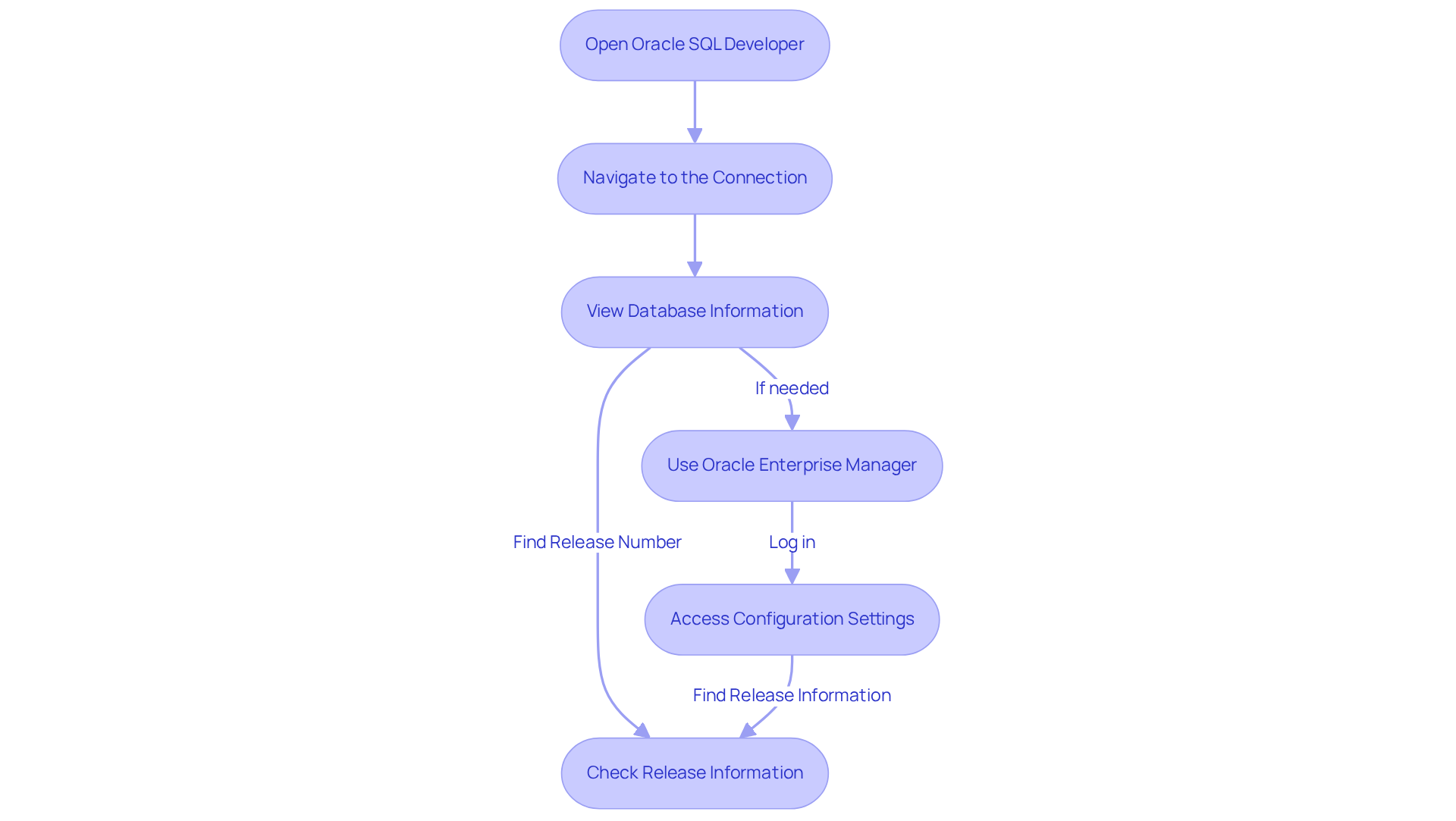
Conclusion
You might be wondering why checking your Oracle database version is such a big deal. Well, it's essential for effective database management! Knowing your version helps ensure compatibility with applications, makes troubleshooting a breeze, facilitates upgrades, and keeps you compliant with regulations. When you're in the know about the specific version you're using, your organization can reduce risks and boost operational efficiency.
Now, let’s dive into the four primary ways to check your Oracle database version:
- SQL commands
- Graphical user interface (GUI) tools
- Database management tools
- Log files
Each method is tailored to different user preferences and skill levels, making it easier for you to access that crucial version information. If you're comfortable with command-line interfaces, SQL commands are a direct approach. But if you prefer something more visual, GUI tools are your friend! Plus, using database management tools can simplify the update-checking process, keeping you informed about your system's status.
Ultimately, regularly checking your Oracle database version isn’t just a best practice; it’s a vital part of effective database management. By weaving these methods into your routine operations, your organization can optimize database performance, enhance security, and ensure compliance with industry standards. Staying proactive about managing your database versions will lead to smoother operations and a more robust data management strategy. So, why not start today?
Frequently Asked Questions
Why is it important to know your Oracle Database version?
Knowing your Oracle Database version is important for compatibility with applications, troubleshooting issues, managing upgrades, and ensuring adherence to industry regulations.
How does knowing the database version help with compatibility?
Different applications and tools rely on specific data storage formats. Knowing your database version helps keep everything in sync across your software ecosystem, preventing compatibility issues and service disruptions.
What role does database version play in troubleshooting?
Knowing the exact version of your database aids in identifying problems and finding targeted solutions. It allows access to the right documentation, which speeds up the resolution process.
Why is it essential to check the database version before upgrading?
Before upgrading, it's crucial to know the database version to ensure compatibility with new features, improved performance, and security updates that protect against vulnerabilities.
How does staying updated with the database version impact performance?
Staying updated is vital for efficiently handling high transaction volumes, as Oracle processes about 33 billion transactions daily. Newer releases typically offer enhancements that improve overall performance.
What are the compliance implications of knowing your database version?
Many industries have strict regulations requiring specific data storage formats. Knowing your version helps ensure compliance, avoiding potential legal and financial penalties associated with non-compliance.
👍
What others are liking
5 Steps to outline your ideal documentation structure
5 MINS READ
Where to start the your journey of mapping out your ideal documentation structure, aligning it with the very heartbeat of your organization?
Defining a winning level of detail in your process
3 MINS READ
What is too much detail, and what is too little? This article described in that winning level detail about what detail is enough.





